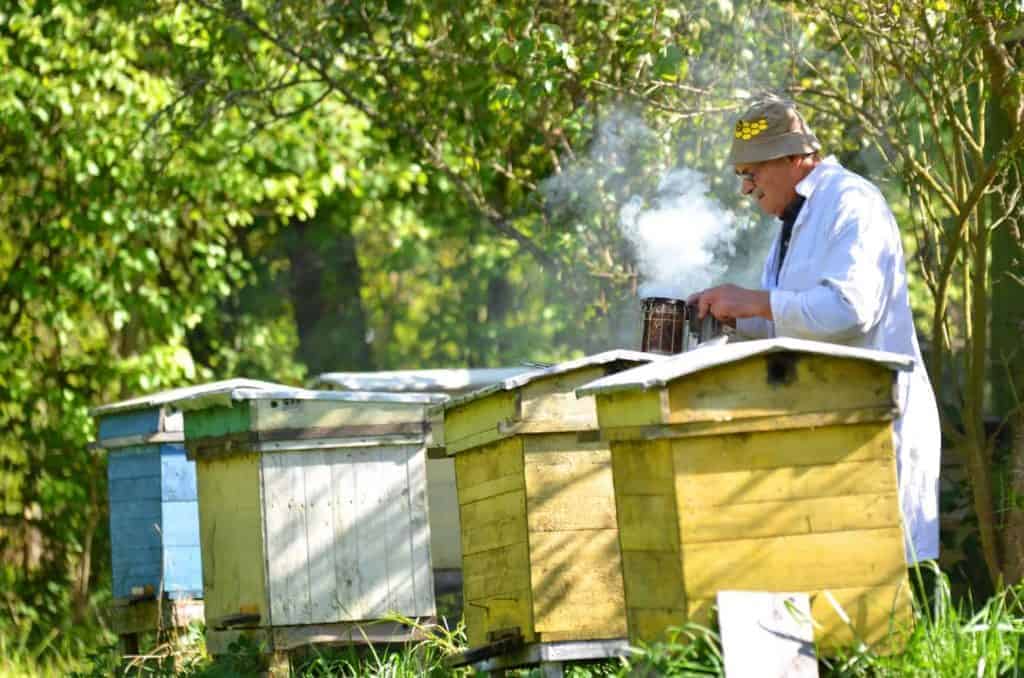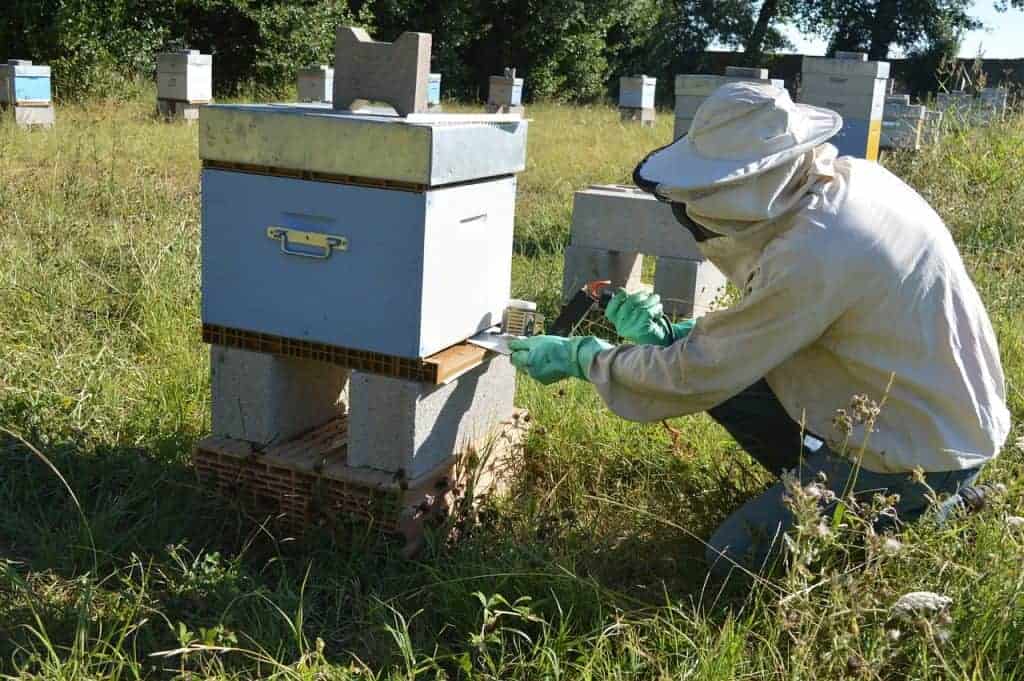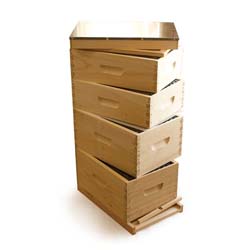Stay ahead of your bees in the spring and things will go much more smoothly than if you are chasing to catch up with them through the rest of the year. Easy to say – but sometimes very challenging to do for a new beekeeper. So let’s take a look at getting ready for the coming summer.

I’ve just finished reading through the notes I took over the course of last season. What great stories! One of the greatest tools a beekeeper can employ to further their understanding of both the bees and the results of actions the beekeeper took is to keep good notes. It’s invaluable, so if you have not yet begun some form of note taking I encourage you to do so now.
I don’t always learn something about each colony when reading my notes and this teaches me what to note each season. It takes a little practice. My own approach is a simple spiral notebook that goes to the bee yard with me every time. Other folks use programs on their phones but I’ve never been able to figure out how their phones don’t become a sticky mess!
Regardless, use whatever leaves you most comfortable. The point is to get started. So get that hot cup of tea (or adult beverage) and take a few moments to review your notes if you took them and think about what worked last season and what did not. It will help you make plans for the season.

Then, when the weather allows, it’s off to the bee yard. The first quick inspections a beekeeper makes can tell a lot about the condition of their colonies and what actions the beekeeper needs to take to begin the season.
On a calm day of at least 50 degrees, you can feel comfortable making a quick inspection of the hive. A couple things to look for are: 1) where is the cluster located in relation to the food stores and 2) how much stored honey is left?
It’s normal to find the cluster off to one side of the hive box and the remaining food reserves on the opposite side of the box. If a stretch of cold weather returns (much like it does during Central Oregon springs) and locks them in place, there is a chance they could starve, because they will not be able to move across the frames to reach the food on the other side.
If you find this to be the case, remove a couple of frames of capped honey from one side and place it NEXT to the clustered bees on the other side. Do not separate frames of brood where the bees are clustered. Do this quickly and then close up the hive.
Even when it’s too cold to open your hives you can check your colonies stores by hefting the back of the hive. But be careful. At 40 degrees bees are unable to move. If you bang the hive and knock bees from the cluster when it’s cold they may not be able to climb back up to join the cluster and will freeze to death.
If the hive is heavy when lifting up the back then it’s likely alright, but if it’s light you will probably need to proceed with some kind of emergency feeding.
Colonies that are alive in March have survived mites and most of winter, but one more challenge awaits them before they see warm weather and a spring nectar flow. So just what is the issue of greatest spring time importance for beekeepers in most northern climates?
The answer is starvation.
In Central Oregon we will get a stretch of weather warm enough to get the first nectar flow going (typically in March) and the bees will react by ramping up their numbers. A few weeks later, due to our relatively high elevation, the warm weather is often followed by a hard frost, killing much of the new spring vegetation and all of the flowers the bees were feeding on.
The significant increase in colony numbers coupled with a loss of the nectar flow on which the bees were relying puts colonies at risk for starvation. Now, a much larger colony will have to wait maybe three to four weeks for the next nectar flow to begin. You will be amazed at how quickly the stores within each colony are used up.
Many options are available to beekeepers, but it does pay to plan ahead. Frames of honey you have saved from last season work the best and if you have a deadout that is free of disease there is likely some honey to be found there as well.
To be on the safe side, frames of honey from a deadout should be frozen at 18 degrees or colder for at least 4 hours to kill pests. They should not be used, of course, if they show signs of disease.
Other options include fondant (simply sugar and water) or sometimes I will simply pour granulated sugar on the inner cover (C@H white sugar – never organic or brown sugar). Another option is to lay newspaper over the top bars, pour granulated sugar on top and spray it with a misting of water. Be sure to create an opening for the bees to easily access this.
And be sure to keep this in mind – now that you have your bees dependent on the food you are providing you cannot stop feeding. You will need to continue to feed until a reliable nectar source becomes available, most likely into April.
One more reminder. In many parts of the country spring is often associated with windy conditions. It makes a lot of sense to have a heavy stone or brick atop your hives to keep the outer cover from blowing off and allowing your bees to freeze.
Soon, depending on your location, you will begin to see bees returning to the hive with pollen. Willow and aspen, followed by maple, will be some of the first new pollen sources available and the bees will seek this out as they get serious about raising new young bees.
Soon after the hard freezes , when the bees are out flying again, is a good time to set up a water source, even though it’s probably going to freeze from time to time. As soon as your bees can begin getting out of the hive they are going to be looking for a source of water.

Once they become oriented to the water you provide they will continue to use it. Spring is the perfect time to make sure they are seeking water in your own backyard and not in someone else’s – such as your neighbor’s hot tub.
We will talk about mites in our later article, but I wanted to make note of a quick way to get a mite count when the weather warms. At your first opportunity, when the weather warms just a bit, you can get a quick and rough mite count without opening your hive for very long. I want to be clear – this “count” is not as accurate as taking a sample of bees for a sugar roll or alcohol wash, but it’s very useful this time of year to gauge if you have an issue or not.
- Put a cup or two (depending on the size of the cluster) of powdered sugar in a sieve and sift it on top of the top bars and cluster (in most hives you will only need to remove the inner cover to do this)
- Brush it down between the frames and wait ten minutes. On the bottom board you have already slid in a sticky board. Ten minutes is supposed to simulate a full day’s natural mite drop.
- After ten minutes, remove the sticky board and count the mites. At this time of year you want no more than a single mite. Typically you will find some hives have 0-1 mites but you may have another with five to ten.
This approach gives you an early look to check the status of your colonies and know in advance how closely you need to watch things. Again, this test is not near as accurate as doing a real count by sampling bees from the hive so I don’t mean to imply it should be a substitute, But as you can see, zero mites gives you a great feel for how things are inside a hive and a high count gives you a good read as well.
If you find numerous mites you can still treat while the weather is cold with oxalic vapor. Keep in mind that any brood in the hive will also be destroyed with this treatment, so it is to be done only when there is little to no brood. Weigh the loss of some brood against the risk to the colony. If you have a high mite count it may be worth the loss of a little brood versus risking the entire colony.

To be clear, I’m not advocating this approach if there is potential to kill much brood, but most of the other treatments require higher temperatures to be effective. On the other hand, you could always wait for warmer temperatures to sample the bees and decide if a treatment is needed. It requires a little bit of experience and each individual chooses to approach this issue differently. Do what seems best to you, learn from it and then be comfortable with your own style and approach to beekeeping.
So while we wait for the weather to warm further and our bees to become active, now is a perfect time to pull out your notes from last season and review what took place in each of your hives last summer.
What? You didn’t take notes last year? Shame on you. A good set of notes is one of your most valuable tools for self instruction. Reviewing notes helps you plan for the coming season and reminds a beekeeper what worked, what they may want to avoid doing and what they need to learn more about.
So get that cup of hot chocolate, sit down in your cozy chair and review your notes from last season to help you make plans for the coming season. As the season warms and the bees get busy, things will happen very fast and you want to be prepared to keep up with your bees.
